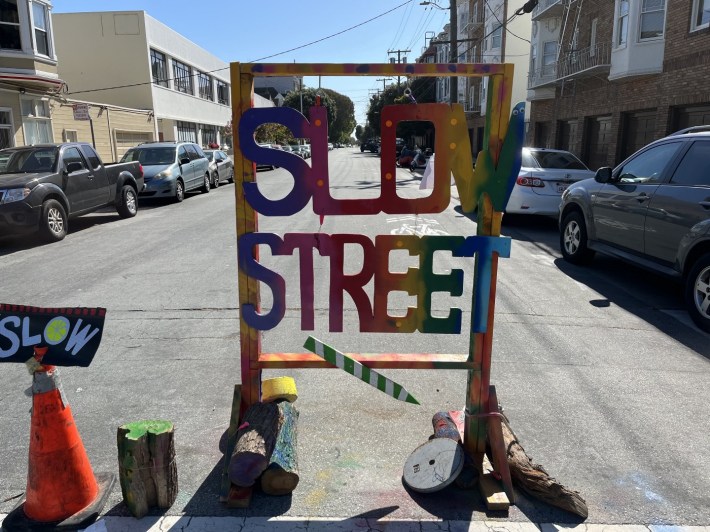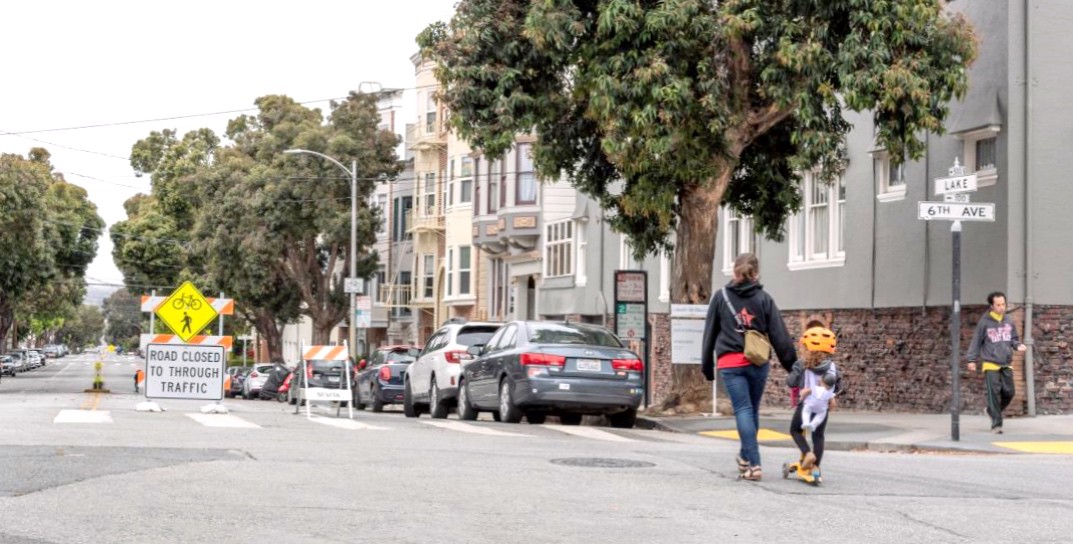This article first appeared in the Frisc and is reprinted with permission.
Perhaps San Francisco should put up a sign for those trying to make its streets safer for cyclists and pedestrians: “Speed bumps ahead.”
A proposed design for a slow Lake Street in the Richmond district has safety advocates fuming, and it comes amid other signs of resistance to prioritizing street safety, public transit, and climate action.
Of the four slow streets approved for permanent status last summer, none may be quite as divisive as Lake Street, which runs roughly 30 blocks in the city’s northwest corner.
In the year since that approval, the San Francisco Municipal Transportation Agency reintroduced the possibility of reopening Lake to through traffic, then did a second round of outreach and traffic studies following the complaints of some neighbors, who insisted that the closure had clogged adjacent streets and made the neighborhood less safe. The results, published in March, showed that slow Lake still enjoyed majority support from residents and did not make traffic on nearby streets worse. All that was left for SFMTA to do, it seemed, was settle on a final design.
Now the agency has unveiled its final design proposal to immediate outcry. The draft does not closely resemble any of the options SFMTA presented earlier this year. Slow streets advocates took to Twitter this week with concerns that the design would strip most existing slow-street signage from the corridor, as well as make Lake more accessible to through traffic. The community group Slow Lake Street warns that the current plan “would mean the end of slow Lake as we know it.”
This comes a week after voters failed to pass Proposition A, which would have authorized a $400 million bond for the city’s cash-strapped transit system. (It fell barely short of the required two-thirds majority required.) Also last week, a disability rights activist and a former SFPD captain submitted a ballot measure proposal to put cars back on JFK Drive, a closure that seemed all but settled after an historic vote in April.
Meanwhile, 15 people have died in traffic this year, seven of them in May alone, even though SF has pledged to eliminate traffic deaths by 2024. The Lake Street process, and the scaled-down proposal it produced, is yet more evidence that the city still struggles with mode shift and street safety.
Design thinking
Currently, wood and sandbag barriers mark most Lake Street intersections, with signs that say “Road closed to through traffic.” Under the proposed design, SFMTA would remove these and install concrete traffic diverters at four intersections.
According to SFMTA spokesperson Erica Kato, “The draft design takes a quality over quantity approach by prioritizing more effective measures at key points along Lake Street.” She adds that the existing signs and barriers are difficult to maintain.
The plan also includes all-way stop signs at six more intersections, and a total of eight new speed cushions and raised crosswalks spread across Lake’s slow blocks. According to SFMTA’s proposal, these measures are designed to preserve local access for residents, delivery vehicles, and emergency response, while discouraging drivers from using Lake to cut through the Richmond.

Kato notes Lake will still be a slow street if the plan goes forward. Pro-slow advocates disagree.
“As the design is proposed, Slow Lake as a community space would no longer exist,” says Luke Bornheimer, an organizer with Community Spaces SF. “It makes me very concerned about the future of projects for our city, specifically around public open space, and I think it sets a dangerous precedent for SFMTA and the city more broadly.”
Traffic-calming projects across the city will not get the injection of funding that SFMTA hoped for, now that the $400 million bond failed to pass during last week’s election. A quarter of that money was earmarked for street improvements. It doesn’t mean that slow streets will be rolled back, but it does mean SFMTA has less financial flexibility in upgrading them.
Roz Arbel, a Richmond district resident and organizer with Friends of Slow Lake, says she appreciates SFMTA’s hard work, but points out it’s “hard to express how disappointed [she is] with the proposed build” and that it doesn’t protect pedestrians enough. Arbel uses a walker due to a spinal cord injury she sustained after tripping on the sidewalk.
She calls Lake Street a safe haven where she can walk slowly without having to worry about speeding cars. But if SFMTA implements its proposal, she feels it would no longer feel comfortable on the street.
Both Arbel and Bornheimer say they would like to see full diagonal diverters — street features that force cars to turn — or block-end closures at every intersection to eliminate cut-through traffic. Neither of these ideas were part of SFMTA’s design options before it settled on the current one.
Stephen Braitsch, a designer who advocates for bike infrastructure and safe streets, adds that there would be less resistance if the barriers were more attractive, pointing to the sign at Page and Stanyan streets as “the hallmark aesthetic we should be aspiring to.”
Bornheimer says diagonal diverters can add trees, plants, and benches to Lake and other streets, serving a dual decorative and functional purpose.

At the same time, those who want full vehicle traffic restored to Lake Street also dislike SFMTA’s new design. An organizer with OpenLakeStreet, who refused to give their name, responded via email to The Frisc that their group is “adamantly opposed to the concrete diverters,” calling them unsafe.
The group’s website continues to post misinformation about the closure, saying it has resulted in more injuries on Lake Street and more gridlock on the adjacent California Street. As The Frisc reported several months ago, neither of these assertions is true, according to SFMTA data.
James Le, another organizer with Friends of Slow Lake, said that since the design went live Monday, SFMTA planners have already spoken with his group as well as the Slow Lake opponents to explain how the design meets everyone’s needs. Despite Le’s alarm with the overall design, he was happy to hear SFMTA say they will keep the current barriers up until the new diverters are installed.
Process, process
The unveiling of the plan marked the start of a two-week public comment period, after which the agency will make tweaks based on feedback. In about a month, the city’s traffic engineer is expected to approve the final design. Since the SFMTA board already voted to make Lake permanently slow in August, it will not vote again on the design — the traffic engineer’s decision will be the “final directive,” according to SFMTA planner Eillie Anzilotti.
The current comment period is the third round of outreach to follow the SFMTA board’s August vote. (For those keeping score, there was an “initial community outreach” last fall, and a “conceptual design outreach” last winter.) Some San Franciscans such as landscape architect Alec Hawley, who is designing a car-free block on Golden Gate Avenue in the Tenderloin, are tired of this process.
“If we are ever to become carbon neutral, or god willing, a climate positive city, this sort of meeting setup needs to end,” Hawley says, referring to SF’s green priorities. “You cannot declare a climate emergency and claim to be a transit-first city and give the same weight to people who do not need, but simply wish to drive.”
Bornheimer of Community Spaces SF says there should be much more outreach in historically underserved neighborhoods, but the Lake Street process is excessive. “This process highlights a deeply flawed system in our city that is oftentimes abused by people who prefer the status quo,” he adds. “In the case of people who oppose community space and sustainable transportation in and around Lake, we end up spending time, money, and staff resources on listening to those people’s complaints and trying to appease them.”
SFMTA’s Kato says that “work[ing] with community and stakeholders” is necessary for finding solutions for each slow street and its surrounding neighborhood. She emphasizes that the current design is a draft and subject to change based on the feedback SFMTA receives during the comment period.
The agency plans to start building the permanent features later this summer, which means it’ll be well over a year between the start of the process and its end.
Max Harrison-Caldwell is a staff writer for The Frisc covering streets, parks, and other shared spaces.





